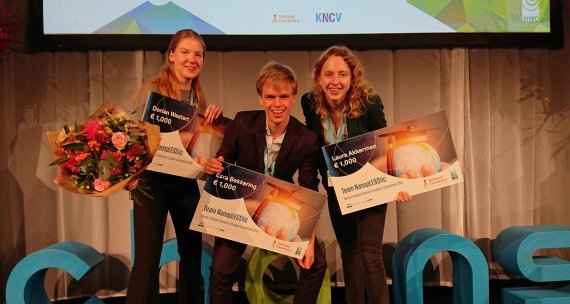© Maarten Smulders
Nano-sized plastic particles end up in the environment in huge quantities. Opinion is divided on how damaging that is and a lot is still unknown. But there is no doubt that man-made plastic particles do not belong in the environment. So the choice of topic for the Holland Chemistry Students Competition was not difficult for BSc students Laura Akkerman, Dorien Westert and Ezra Bekkering.
Unexplored
‘The assignment for the competition is to find a technological solution to a societal problem,’ says Akkerman. ‘A lot of research is already being done on microplastics, whereas much less is known about nanoplastics.’ ‘But that is precisely why there are still a lot of unexplored areas,’ adds Bekkering. So the three honours students set to work developing a filter that can detect and remove nanoplastics. The method they chose is simple: adsorption onto activated carbon (also known as activated charcoal). The mechanism that activated carbon – Norit – works by is well known: It purges impurities by adsorption. But it was possible that there might be ways of seriously improving that bonding by adding a coating. The competition organizers saw promise in the submission last spring of this idea, dubbed NanopLESStic, and the three Molecular Life Sciences students were given 27,000 euros to test the concept.
Eternal fame
As the coating, the students used a layer of silane with methyl or phenyl groups as hooks to catch the plastic particles. They used nanoparticles of polystyrene as the test material. And the technique turned out to work. The experiments showed that the phenyl group in particular was effective in trapping the nanoparticles. Carbon with the coating extracts four times as much nanoplastic out of the water as uncoated carbon. The students reckon this proves the concept. ‘It works with this combination of coating and plastic,’ says Bekkering. ‘Even 100 per cent purification is feasible. We might need different coatings for other nanoplastics. But you can easily modify the surface of the carbon with this method.’ At any rate, the students won the chemistry competition with this concept, which gets them eternal fame and 1000 euros each.
Chloroform
A fantastic result, agrees chemist Louis de Smet, one of the group’s supervisors. It remains to be seen whether the concept has a future outside the lab, though. He foresees some obstacles. ‘This works in the lab. But in real life you have various other compounds in the waste water that can also bond with the carbon. That is called fouling, when biomaterial is deposited on the filter. Can you prevent this nonspecific adsorption? In other words, how selective can you make the filter? And can you reuse the filter? At present, the students are using chloroform to remove the nanoplastics. You can do this in the lab but using an anaesthetic isn’t an option in practice, of course.’ De Smet and his colleagues Maarten Smulders and Elinor Scott will be considering how to develop the method further. RK

